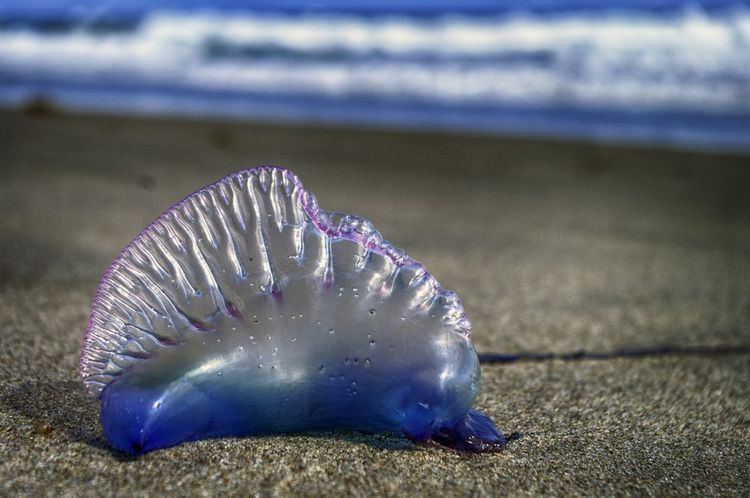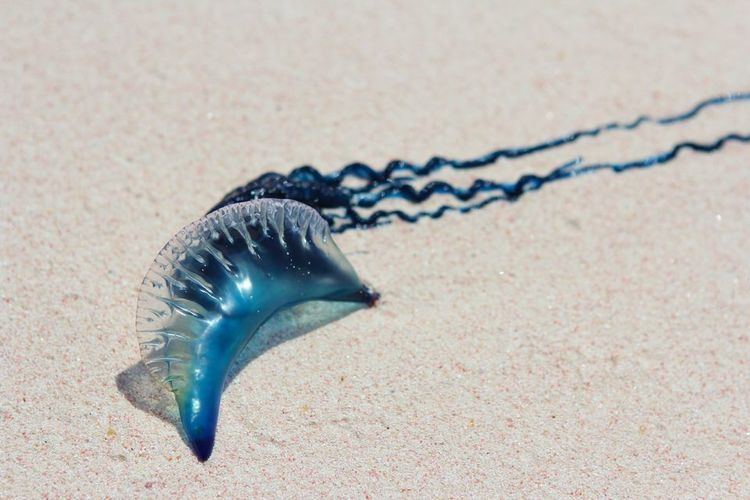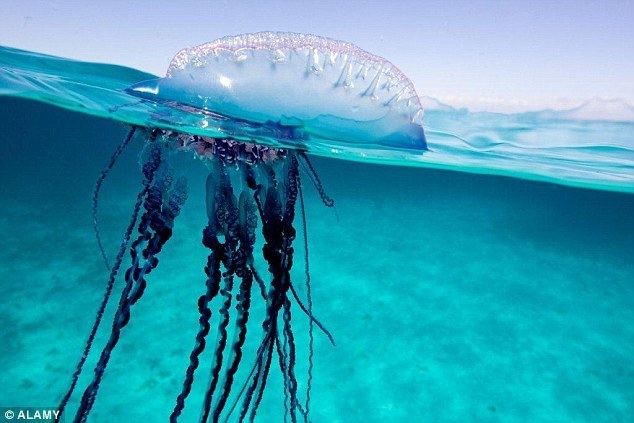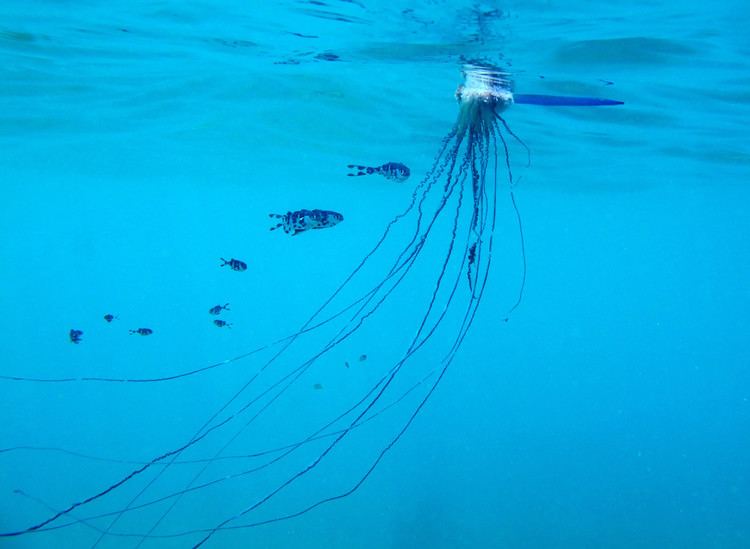Order Siphonophora Rank Species | Family Physaliidae Scientific name Physalia physalis Higher classification Physalia | |
 | ||
Similar Jellyfish, Physalia, Siphonophorae, Cnidaria, Hydrozoa | ||
Portuguese man o war an organism made of organisms
The Atlantic Portuguese man o' war (Physalia physalis), also known as the man-of-war, blue bottle, or floating terror, is a marine hydrozoan of the family Physaliidae found in the Atlantic Ocean, as well as the Indian and Pacific Oceans. Its venomous tentacles can deliver a painful (and sometimes fatal) sting. Despite its outward appearance, the Portuguese man o' war is not a jellyfish but a siphonophore, which, unlike jellyfish, is not actually a single multicellular organism, but a colonial organism made up of specialized individual animals called zooids or polyps. These polyps are attached to one another and physiologically integrated to the extent that they are unable to survive independently, and therefore have to work together and function like a so-called individual animal.
Contents
- Portuguese man o war an organism made of organisms
- Portuguese man o war washing ashore
- Name origin
- Habitat
- Structure
- Venom
- Treatment of stings
- Predators and prey
- Commensalism and symbiosis
- References

The Indo-Pacific Portuguese man-of-war (P. utriculus), or blue bottle, is a related species with very similar appearance found throughout the Indian and Pacific Oceans.

Portuguese man o war washing ashore
Name origin

The name "man o' war" comes from the man-of-war, an 18th-century armed sailing ship, and the cnidarian's supposed resemblance to the Portuguese version at full sail. In other languages, it is known as the 'Portuguese war-ship' (Dutch: Portugees oorlogsschip, Norwegian: portugisisk krigsskip, Finnish: portugalinsotalaiva, Chinese: 葡萄牙戰艦; pinyin: Pútáoyá zhànjiàn), the 'Portuguese galley' (German: portugiesische Galeere, Hungarian: portugál gálya), the 'Portuguese caravel' (Portuguese: caravela portuguesa, Spanish: carabela portuguesa, Italian: caravella portoghese), the 'Portuguese little boat' (Russian: португальский кораблик), the 'monk's hat jellyfish' (Chinese: 僧帽水母; pinyin: sēngmào shuǐmǔ), or the 'skipjack's eboshi-hat' (katsuo no eboshi (Japanese: 鰹の烏帽子)).
Habitat

The Atlantic Portuguese man o' war lives at the surface of the ocean. The gas-filled bladder, or pneumatophore, remains at the surface, while the remainder is submerged. As the Portuguese man o' war has no means of propulsion, it moves according to the winds, currents, and tides. Although it is most commonly found in the open ocean in tropical and subtropical regions, it has been found as far north as the Bay of Fundy and the Hebrides.

Strong winds may drive them into bays or onto beaches. Often, finding a single Portuguese man o'war is followed by finding many others in the vicinity. They can sting while beached; the discovery of a man o' war washed up on a beach may lead to the closure of the beach.
Structure

The Portuguese man o' war colony is composed of three types of medusoids (gonophores, siphosomal nectophores, and vestigial siphosomal nectophores) and four types of polypoids (free gastrozooids, gastrozooids with tentacles, gonozooids, and gonopalpons), grouped into cormidia beneath the pneumatophore, a sail shaped structure filled with gas. The pneumatophore should probably not be considered a polyp, as it develops from the planula, unlike the other polyps. This sail is bilaterally symmetrical, with the tentacles at one end. It is translucent, and is tinged blue, purple, pink, or mauve. It may be 9 to 30 cm (3.5 to 11.8 in) long and may extend as much as 15 cm (5.9 in) above the water. The Portuguese man o' war fills its gas bladder with up to 14% carbon monoxide. The remainder is nitrogen, oxygen, and argon—atmospheric gases that diffuse into the gas bladder. Carbon dioxide also occurs at trace levels. The sail is equipped with a siphon. In the event of a surface attack, the sail can be deflated, allowing the organism to briefly submerge.
The other three polyp types are known as dactylozooid (defense), gonozooid (reproduction), and gastrozooid (feeding). These polyps are clustered. The dactylzooids make up the tentacles that are typically 10 m (33 ft) in length, but can reach over 30 m (98 ft). The long tentacles "fish" continuously through the water, and each tentacle bears stinging, venom-filled nematocysts (coiled, thread-like structures), which sting and kill adult or larval squids and fishes. Large groups of Portuguese man o' war, sometimes over 1,000 individuals, may deplete fisheries. Contractile cells in each tentacle drag the prey into range of the digestive polyps, the gastrozooids, which surround and digest the food by secreting enzymes that break down proteins, carbohydrates, and fats, while the gonozooids are responsible for reproduction.
Venom
This species and the smaller Indo-Pacific man o' war (Physalia utriculus) are responsible for up to 10,000 human stings in Australia each summer, particularly on the east coast, with some others occurring off the coast of South Australia and Western Australia. One of the problems with identifying these stings is that the detached tentacles may drift for days in the water, and the swimmer may not have any idea if he or she has been stung by a man o' war or by some other less-venomous creature.
The stinging, venom-filled nematocysts in the tentacles of the Portuguese man o' war can paralyze small fish and other prey. Detached tentacles and dead specimens (including those that wash up on shore) can sting just as painfully as the live organism in the water and may remain potent for hours or even days after the death of the organism or the detachment of the tentacle.
Stings usually cause severe pain to humans, leaving whip-like, red welts on the skin that normally last two or three days after the initial sting, though the pain should subside after about 1 to 3 hours (depending on the biology of the person stung). However, the venom can travel to the lymph nodes and may cause symptoms that mimic an allergic reaction including swelling of the larynx, airway blockage, cardiac distress, and an inability to breathe (though this is not due to a true allergy, which is defined by serum IgE). Other symptoms can include fever and shock, and in some extreme cases, even death, although this is extremely rare. Medical attention for those exposed to large numbers of tentacles may become necessary to relieve pain or open airways if the pain becomes excruciating or lasts for more than three hours, or breathing becomes difficult. Instances where the stings completely surround the trunk of a young child are among those that are potentially fatal.
Treatment of stings
Though often extremely painful, most stings from a Portuguese man o' war do not require immediate medical treatment. The stings result in severe dermatitis characterized by long, thin open wounds that resemble those caused by a whip. These are not caused by any impact or cutting action, however, but by irritating urticariogenic substances in the tentacles. The usual round of treatment for a Portuguese man o' war sting begins with the application of poured salt water to rinse away any remaining microscopic nematocysts—rubbing or touching the wound causes the discharge of any nematocysts still attached to the skin. Rinsing with salt water helps wash these "unfired" nematocysts away from the wound, though it does not directly relieve the pain (also, as this rinse water will likely contain some nematocysts, care should be taken to keep it from running over the victim's skin: salt water poured down a leg may result in fresh stings suddenly appearing on the feet, for example). Fresh water has been shown to cause nematocystic discharge and is not recommended for this purpose.
Following rinsing with saltwater, the traditional next treatment step involves soaking the wound in acetic acid in a 5% solution (this is the proportion of acetic acid available in household vinegar) or in a solution of ammonia and water (three parts water to one of ammonia). This is believed to deactivate the remaining nematocysts and usually provides some pain relief, though some isolated studies suggest that in some individuals vinegar dousing may increase toxin delivery and worsen symptoms. Vinegar has also been claimed to provoke hemorrhaging when used on the less severe stings of cnidocytes of smaller species, which is why the determination of the origin of the stings, if possible, is so important. The current recommended treatment from studies in Australia is to avoid the use of vinegar, as local studies have shown this to exacerbate the symptoms.
The vinegar or ammonia soak is then often followed by the application of shaving cream to the wound for 30 seconds, followed by shaving the area with a razor and rinsing the razor thoroughly between each stroke. This removes any remaining unfired nematocysts. Once shaved, the wound is then resoaked in either vinegar or ammonia. If available, heat in the form of hot salt water (not fresh) or hot packs is then applied at temperatures as hot as the victim can tolerate: heat speeds the breakdown of the toxins already in the skin. After a few hours, a thin layer of hydrocortisone cream at 1% concentration is applied. The victim must then be monitored over the next several days to see if the wound becomes infected: symptoms of infection such as fresh reddening of the wound's edges, the production of pus, the development of a fever, the swelling or hardening of the lymph nodes nearest the wound, etc., indicate that the hydrocortisone is to be discontinued and professional medical treatment may then be necessary.
Predators and prey
The Portuguese man o' war is a carnivore. Using its venomous tentacles, a man o' war traps and paralyzes its prey. It typically feeds on small marine organisms, such as fish and plankton, and has few predators of its own.
Exceptions to this are the loggerhead turtle, which feeds on the Portuguese man o' war as a common part of its diet. The turtle's skin, including that of its tongue and throat, is too thick for the stings to penetrate.
The blue sea slug Glaucus atlanticus specializes in feeding on the Portuguese man o' war, as does the violet snail Janthina janthina.
The blanket octopus is immune to the venom of the Portuguese man o' war; young individuals carry broken man o' war tentacles, presumably for offensive and/or defensive purposes.
The ocean sunfish's primary diet consists of jellyfish, but it also consumes the Portuguese man o' war.
Commensalism and symbiosis
A small fish, Nomeus gronovii (the man-of-war fish or shepherd fish), is partially immune to the venom from the stinging cells and can live among the tentacles. It seems to avoid the larger, stinging tentacles but feeds on the smaller tentacles beneath the gas bladder. The Portuguese man o' war is often found with a variety of other marine fish, including clownfish and yellow jack. The clownfish can swim among the tentacles with impunity, possibly owing to their mucus, which does not trigger the nematocysts.
All these fish benefit from the shelter from predators provided by the stinging tentacles, and for the Portuguese man o' war, the presence of these species may attract other fish to eat.
